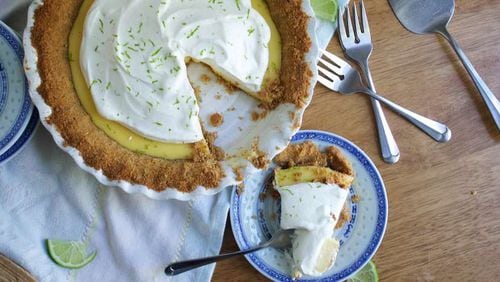In the Southern Kitchen series Saving Southern Recipes, Editor-in-Chief Kate Williams explores the deep heritage of Southern cooking through the lens of passed-down family recipes.
My favorite fact about Key lime pie is that the man who claims to know the original version of the recipe found the recipe while researching a ghost. It may have been the ghost of the first baker of the pie, or else it was a ghost who lived somewhere else in a palatial mansion funded at least in part by the sale of one key Key lime pie ingredient.
My other favorite fact is that this man, David Sloan, a.k.a. the self-described leading American Key lime pie expert, is not a true Floridian, but a Texan adopted by the Southernmost part of the United States. He came to the Keys by way of college and cruise ships, but seemed to really come into his own once he got into the ghost tour business. It was during one of his tours of the home of William "Bill Money" Curry, who was a hardware magnate and the first person to bring sweetened condensed milk to the Keys in the mid-19th century, that Sloan found the recipe in a kitchen cupboard.
There are a few competing histories of Key lime pie. The first, and in my opinion, the most realistic, is that the first such "pies" were crustless and made from a mixture of lime juice, pelican eggs and sweetened condensed milk. These were assembled by sponge fishermen working in the ocean around the Keys, and were made without needing heat — the acid from the Key limes reacts with the egg yolks to thicken the mixture, almost like a custard, and the condensed milk acts as a sweetener. Another theory, albeit one usually discounted by historians, is that Key lime pie was an invention of botanist Jack Simons. The story Sloan believes is that the original pie came from that now-haunted mansion, and Curry's cook, known as "Aunt Sally." It was Aunt Sally's spirit, said Sloan, that led him to her original recipe, which he shared in his book, "The Ultimate Key Lime Pie Cookbook."
(If you want to dive deeper into the psyche of the Key lime expert, take a look at a few of his other titles: "Hangover Survival Guide", "Quit Your Job and Move to Key West" and "Don't Do It! 101 Reasons NOT to Marry Her.")
Aunt Sally could very well have been the first cook to put a lime-and-condensed milk custard inside of a crust, but she likely got the idea for the filling from the fishermen. And while Sloan says she would have used whipped cream as a topping, you're still likely to encounter plenty of Floridians who claim that true Key lime pie is always topped with a toasted meringue. I'd side with Sloan on this one, just based on the challenges of creating a perfect meringue in a humid environment without the aid of egg beaters. Also, whipped cream just tastes better.
But whatever the topping on her pie, we know that the filling was certainly made with a very different lime than what is used in most American kitchens today. The original Key limes, which flourished in the area for years, were pretty much entirely wiped out by a hurricane in 1926. As the islands recovered, heartier Persian limes were brought in to replace the Key lime crop, and today, you're only likely to encounter a true Florida Key lime in someone's backyard. Those Key limes you may find at your grocery store? Those are quite frequently from Mexico or California, and, in my experience, tend to be rock hard and frustrating to juice.
Most Key lime pies, therefore are made with juicier and more acidic Persian limes, which make for a pie that actually needs that extra sugar from a meringue and a graham cracker crust for balance. If, however, you want to bake a pie (and you should) that tastes more like Key limes without having to track down your own personal backyard grower, simply use a mix of Persian lime and lemon juice. A touch of lemon will temper and balance the tart lime without needing to resort to dumping even more sugar into the dessert. (This is also the secret, in my mind, to a great margarita.) I like to use about 75 percent lime juice and 25 percent lemon, but these proportions are entirely up to you — and Key lime pie is easy enough that you should have no trouble baking through as many as you need in order to land on your perfect ratio, ghost or no ghost.
About the Author






